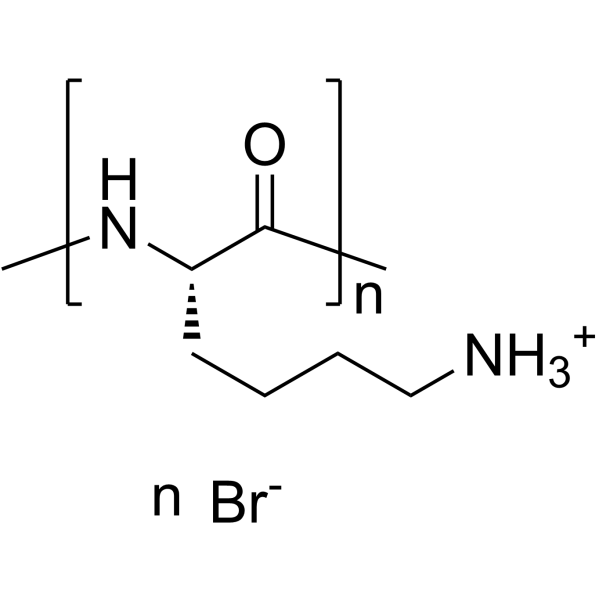Poly-L-lysine hydrobromide

Poly-L-lysine hydrobromide structure
|
Common Name | Poly-L-lysine hydrobromide | ||
|---|---|---|---|---|
| CAS Number | 25988-63-0 | Molecular Weight | 227.09900 | |
| Density | 1.156g/cm3 | Boiling Point | 745.4ºC at 760mmHg | |
| Molecular Formula | (C6H14N2O2)n.nBrH | Melting Point | N/A | |
| MSDS | Chinese USA | Flash Point | 404.6ºC | |
|
Receptor for Advanced Glycation End-Products Signaling Interferes with the Vascular Smooth Muscle Cell Contractile Phenotype and Function.
PLoS ONE 10 , e0128881, (2015) Increased blood glucose concentrations promote reactions between glucose and proteins to form advanced glycation end-products (AGE). Circulating AGE in the blood plasma can activate the receptor for advanced end-products (RAGE), which is present on both endot... |
|
|
The Parkinson's disease protein LRRK2 impairs proteasome substrate clearance without affecting proteasome catalytic activity.
Cell Death Dis. 2 , e196, (2011) Leucine-rich repeat kinase 2 (LRRK2) mutations are the most common known cause of Parkinson's disease (PD). The clinical features of LRRK2 PD are indistinguishable from idiopathic PD, with accumulation of α-synuclein and/or tau and/or ubiquitin in intraneuron... |
|
|
Astrocyte-derived tissue transglutaminase interacts with fibronectin: a role in astrocyte adhesion and migration?
PLoS ONE 6(9) , e25037, (2011) An important neuropathological feature of neuroinflammatory processes that occur during e.g. Multiple Sclerosis (MS) is the formation of an astroglial scar. Astroglial scar formation is facilitated by the interaction between astrocytes and extracellular matri... |
|
|
Soluble factors from neocortical astrocytes enhance neuronal differentiation of neural progenitor cells from adult rat hippocampus on micropatterned polymer substrates.
J. Biomed. Mater. Res. A 91(2) , 575-85, (2009) Rat adult hippocampal progenitor cells (AHPCs) are self-renewing, multipotent neural progenitors that have the ability to differentiate into neurons and glia. Previously, we demonstrated that coculture of AHPCs with postnatal day 2, type 1 cortical astrocytes... |
|
|
Major surface protein LipL32 is not required for either acute or chronic infection with Leptospira interrogans.
Ann. Biomed. Eng. 41(10) , 2181-92, (2013) Leptospira interrogans is responsible for leptospirosis, a zoonosis of worldwide distribution. LipL32 is the major outer membrane protein of pathogenic leptospires, accounting for up to 75% of total outer membrane protein. In recent times LipL32 has become th... |
|
|
Tetraspanin CD9 determines invasiveness and tumorigenicity of human breast cancer cells.
Oncotarget 6 , 7970-91, (2015) Interaction of breast cancer cells (BCCs) with stromal components is critical for tumor growth and metastasis. Here, we assessed the role of CD9 in adhesion, migration and invasiveness of BCCs. We used co-cultures of BCCs and bone marrow-derived multipotent m... |
|
|
TUT7 controls the fate of precursor microRNAs by using three different uridylation mechanisms.
EMBO J. 34(13) , 1801-15, (2015) Terminal uridylyl transferases (TUTs) function as integral regulators of microRNA (miRNA) biogenesis. Using biochemistry, single-molecule, and deep sequencing techniques, we here investigate the mechanism by which human TUT7 (also known as ZCCHC6) recognizes ... |
|
|
Differential use of autophagy by primary dendritic cells specialized in cross-presentation.
Autophagy 11 , 906-17, (2015) Antigen-presenting cells survey their environment and present captured antigens bound to major histocompatibility complex (MHC) molecules. Formation of MHC-antigen complexes occurs in specialized compartments where multiple protein trafficking routes, still i... |
|
|
Mitochondrial function provides instructive signals for activation-induced B-cell fates.
Nat. Commun. 6 , 6750, (2015) During immune reactions, functionally distinct B-cell subsets are generated by stochastic processes, including class-switch recombination (CSR) and plasma cell differentiation (PCD). In this study, we show a strong association between individual B-cell fates ... |
|
|
Pcdh11x Negatively Regulates Dendritic Branching.
J. Mol. Neurosci. 56 , 822-8, (2015) Proper formation of neuronal dendritic branching is crucial for correct brain function. The number and distribution of receptive synaptic contacts are defined by the size and shape of dendritic arbors. Our previous research found that protocadherin 11 X-linke... |